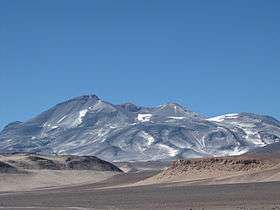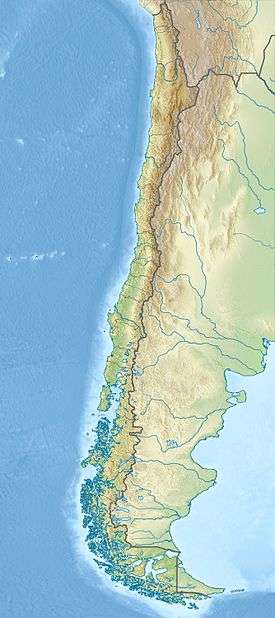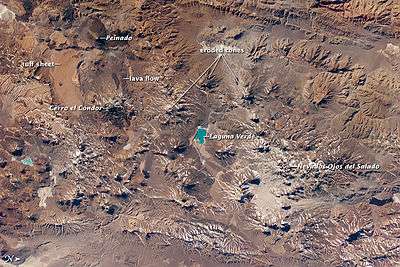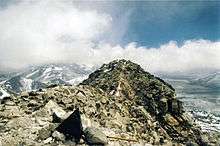Ojos del Salado
| Ojos del Salado | |
|---|---|
 The volcano looming on the horizon. | |
| Highest point | |
| Elevation | 6,893 m (22,615 ft) [1] |
| Prominence |
3,688 m (12,100 ft) [1] Ranked 44th |
| Isolation | 631 kilometres (392 mi) |
| Listing |
Volcanic Seven Summits Seven Second Summits Country high point Ultra |
| Coordinates | 27°06′35″S 68°32′29″W / 27.10972°S 68.54139°WCoordinates: 27°06′35″S 68°32′29″W / 27.10972°S 68.54139°W |
| Geography | |
 Ojos del Salado Location on the Argentina–Chile border | |
| Location | Argentina–Chile |
| Parent range | Andes |
| Geology | |
| Mountain type | stratovolcano |
| Last eruption | 700 CE ± 300 years[2] |
| Climbing | |
| First ascent | February 26, 1937 by Jan Alfred Szczepański and Justyn Wojsznis |
| Easiest route | Scramble |

Nevado Ojos del Salado is a stratovolcano in the Andes on the Argentina–Chile border and the highest active volcano in the world at 6,893 m (22,615 ft). It is also the second highest mountain in the Western Hemisphere and Southern Hemisphere and the highest in Chile. It is located about 600 km (370 mi) north of Aconcagua, the highest mountain in the Western Hemisphere at 6,961 m (22,838 ft).
Due to its location near the Atacama Desert, the mountain has very dry conditions with snow usually only remaining on the peak during winter, though heavy storms can cover the surrounding area with a few feet of snow even in summer. Despite the generally dry conditions, there is a permanent crater lake about 100 m (330 ft) in diameter at an elevation of 6,390 m (20,960 ft) on the eastern side of the mountain.[3] This is most likely the highest lake of any kind in the world.
The ascent of Ojos del Salado is mostly a hike except for the final section to the summit which is a difficult scramble that may require ropes. The first ascent was made in 1937 by Jan Alfred Szczepański and Justyn Wojsznis, members of a Polish expedition in the Andes.
Its name, meaning roughly "Eyes of the Salty One" in Spanish, comes from the enormous deposits of salt that, in the form of lagoons or “eyes”, appear in its glaciers.[4]
Volcanic activity
There is no doubt that Ojos del Salado is active volcano, but the question of whether it should be considered currently (or "historically") active is arguable. According to the Smithsonian Institution's Global Volcanism Program,[2] the most recent known eruption was around 1300 years ago, with large error bars. However, there is also some evidence for a minor ash emission in 1993, which would definitely qualify the volcano as historically active. The presence of fumaroles high on the mountain and recent-looking lava flows, albeit of uncertain age, also argues in favor of a categorization as "active." By these definitions Ojos del Salado is the highest historically active volcano on earth. If the older date is accepted, the title of "highest historically active volcano" might reside instead with the somewhat lower Llullaillaco volcano, which certainly has erupted in historic times (most recently in 1877) and should still be considered active. Its last eruption was 1000–1500 years ago
Composition
Salado's rock is predominantly potassium-rich dacite and rhyodacite. Its lavas are high in biotite, hornblende, plagioclase, and opaques, with lower levels of augite, quartz, and hypersthene.[5]
Elevation
The elevation of Ojos del Salado has been the subject of debate. A 2006 article in Andes Magazine offered that Ojos del Salado may be higher than Aconcagua, although the argument was premised on older, less accurate altitude surveys. The results of these older surveys assigned Ojos del Salado an elevation of 7,057 m (23,153 ft), which would have made it nearly 100 m (330 ft) higher than Aconcagua. As early as 1955, an estimate was made that the elevation of Ojos del Salado was 7,100 m (23,300 ft), but that was "simply [...] based on the altitude of the final camp, and the hours of ascent to the summit."[6] In 1956 the first Chilean expedition led by the retired lieutenant René Gajardo measured the height of Ojos del Salado as 7,084 m (23,241 ft) with a pocket pressure altimeter. Apart from being an inexact method, the height shown by the altimeter was far too high as air pressure is generally lower in the afternoon, the time at which the team reached the summit.[7]
An expedition to the area in the 90s claimed that nearby Monte Pissis was even higher than Ojos del Salado. Later measurements using more precise equipment showed that Ojos del Salado is about 100 m (330 ft) higher than Pissis. Furthermore, in 2007 a Chilean–Argentine–European expedition organized by Andes Magazine and Azimut 360 performed a survey on both Ojos del Salado and Monte Pissis using more accurate instruments. It found the former to be 6,891 m (22,608 ft) and the latter 6,793 m (22,287 ft)[8] Although this fits within recent handheld GPS surveys, which have estimated the mountain to be between 6,880 m (22,570 ft) and 6,910 m (22,670 ft), the vertical error margin of the expedition's equipment, 10 m (33 ft),[8] leaves uncertainty as to the mountain's more precise altitude.
Ojos del Salado has two summits, one in Argentina and the other in Chile (the border between the two countries runs between the two summits). The difference in elevation of the two summits is less than 1 m (3 ft 3 in)
Motorized partial ascent

Ojos del Salado has been a popular mountain for attaining the highest altitude aboard a land vehicle. On 22 March 2005 a team led by Matthias Jeschke drove their Toyota Landcruiser 90, V6 at 6,010 meters (19,717 ft) and set a new high altitude record for four-wheeled vehicles. They performed pioneer work by exploring the area around 6,000 m (19,685 ft) for the first time, what paved the way for further attempts to surpass this record. After that, an Extrem Events Team and a VW Team established 4 more high altitude records (Extrem Events 6,010 m on 20 Feb, 2005, VW Team 6,081 m on 17 Feb, 2005, Extrem Events 6,358 m on 2 March 2005, Extrem Events 6,646 m on 13 March 2007). On 21 April 2007, the Chilean duo of Gonzalo Bravo G. and Eduardo Canales Moya beat the previous record when they reached an altitude of 6,688 meters (21,942 ft.) with a modified Suzuki Samurai, setting the latest record for the highest altitude attained by a four-wheeled vehicle. The first high altitude record for trucks was set by a team around Matthias Jeschke. They drove at 6,675 meters (21,899 ft) with a Mercedes Benz Zetros Truck and established a high altitude record not only for trucks but also for diesel-powered motors. On 19 April 2015 Chilean Gianfranco Bianchi reached an altitude of 6,472 m (21,233 ft) with a Suzuki RMZ 450 and set the latest record for motorbikes.
See also
- Cerro El Muerto
- Cerro Solo
- Incapillo
- Incahuasi
- Laguna Verde
- List of volcanoes in Argentina
- List of volcanoes in Chile
- Lists of volcanoes
- Llullaillaco
- Nevado Tres Cruces
- Tipas
- Volcanic Seven Summits
References
- 1 2 "Andes ultra-prominent peaks". Peaklist.
- 1 2 "Ojos del Salado". Global Volcanism Program. Smithsonian Institution.
- ↑ "Andes Website – Information about Ojos del Salado volcano, a high mountain in South America and the World's highest volcano".
- ↑ "Los 6000 de Chile". Banco de Chile.
- ↑ "Nevados Ojos del Salado". Volcano World. Oregon State University. 2011. Retrieved July 29, 2011.
- ↑ American Alpine Journal, 1956, p. 134; quoting the "Boletin Informativo No. 16" (June 1955) of the Argentine Associación Tucumana de Andismo.
- ↑ Lliboutry 1956.
- 1 2 "A la Búsqueda del Techo de América" (in Spanish).
Phillipe Reuter: "El Ojos del Salado es 100 metros más alto que el Pissis"
Bibliography
- Volcanes de Chile (in Spanish). Santiago, Chile: Instituto Geográfico Militar. 1995. p. 640. ISBN 956-202-054-1.
|first1=missing|last1=in Authors list (help) (Also includes volcanoes of Argentina, Bolivia, and Peru) - De Silva, Shanaka L.; Francis, Peter (1991). Volcanoes of the Central Andes. Springer-Verlag. p. 216. ISBN 3-540-53706-6.
- Biggar, John (2005). The Andes: A Guide for Climbers (3 ed.). Scotland: Andes Publishing. p. 304. ISBN 0-9536087-2-7.
- Lliboutry, Luis (1956). Nieves y Glaciares de Chile: Fundamentos de glaciología (in Spanish).
External links
| Wikimedia Commons has media related to Ojos del Salado. |
- Complete description of Ojos del Salado in Andeshandbook
- 1 December 2006 Star Trails at 19,000 Feet - NASA Astronomy Picture of the Day
- Andes information
- Peak bagger
- Summit post
- Peak list